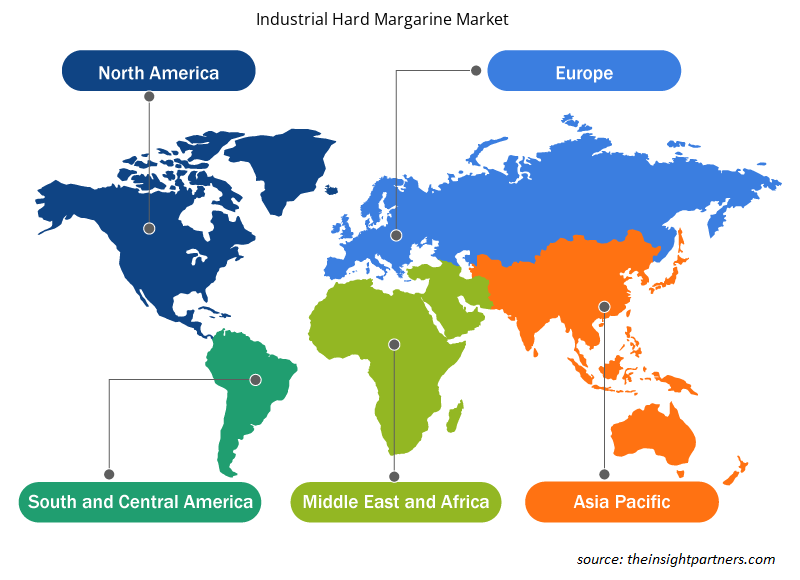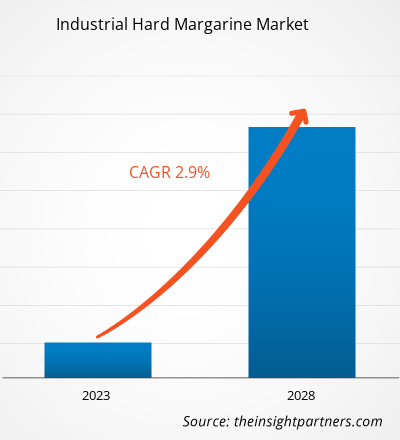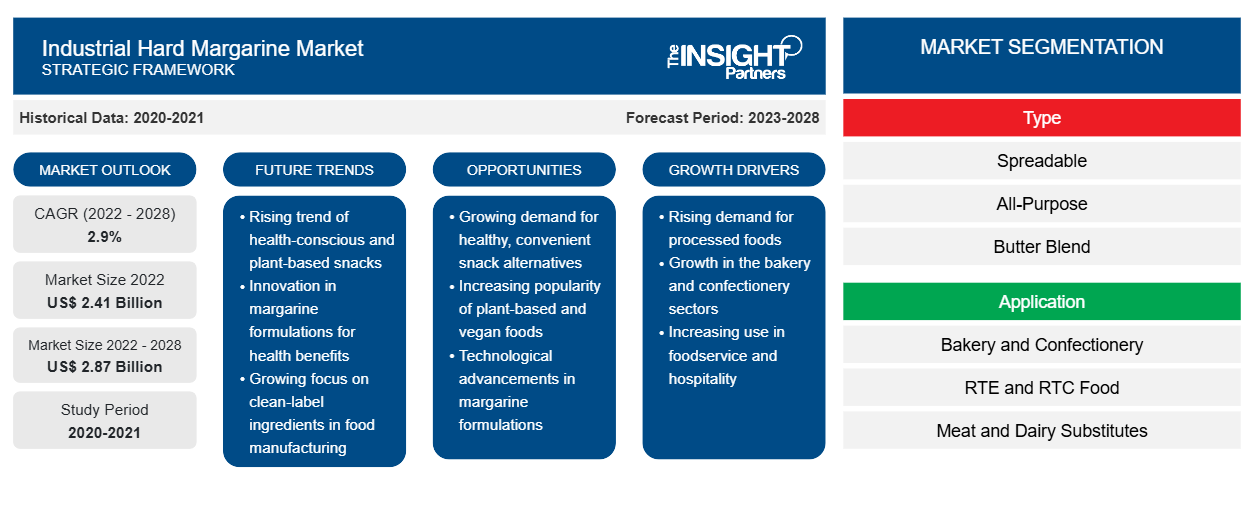Si prevede che il mercato della margarina dura industriale crescerà da 2.414,51 milioni di dollari nel 2022 a 2.869,63 milioni di dollari entro il 2028; si stima che registrerà un CAGR del 2,9% dal 2022 al 2028.CAGR of 2.9% from 2022 to 2028.
La margarina è prodotta idrogenando oli vegetali come olio di palma, olio di girasole, olio di canola e olio di cartamo. In genere, la margarina dura ha un contenuto di acidi grassi saturi maggiore rispetto ad altri tipi di margarina, come la margarina morbida/in vaschetta e la margarina liquida. La crescente domanda di margarina dura nel settore alimentare e delle bevande per applicazioni di panetteria e pasticceria sta guidando significativamente il mercato. Inoltre, il crescente consumo di prodotti da forno confezionati dovuto al cambiamento degli stili di vita e all'evoluzione delle preferenze dei consumatori sta guidando il mercato della margarina dura industriale
Nel 2022, il Nord America ha detenuto la quota maggiore del mercato della margarina dura industriale. Si stima che il mercato nell'area Asia-Pacifico crescerà al CAGR più elevato durante il periodo di previsione. I consumatori si stanno orientando verso uno stile di vita sano e preferiscono prodotti che forniscono benefici per la salute, a causa della crescente incidenza di malattie come diabete, ipertensione e stitichezza. Secondo i Centers for Diseases Control and Prevention (CDC), 37,3 milioni di persone negli Stati Uniti soffrivano di diabete nel 2021. Inoltre, la domanda di alimenti di origine vegetale è aumentata nella popolazione giovane, il che sta alimentando la crescita del mercato della margarina dura industriale. Inoltre, l'industria di trasformazione alimentare consolidata nella regione utilizza la margarina dura industriale per preparare diversi prodotti alimentari. I principali produttori di trasformazione alimentare nella regione si stanno concentrando sull'adozione di alternative a basso costo al burro, il che sta aumentando la domanda di margarina dura industriale.
Personalizza questo report in base alle tue esigenze
Riceverai la personalizzazione gratuita di qualsiasi report, comprese parti di questo report, o analisi a livello nazionale, pacchetto dati Excel, oltre a usufruire di grandi offerte e sconti per start-up e università
-
Scopri le principali tendenze di mercato in questo rapporto.Questo campione GRATUITO includerà analisi di dati che spaziano dalle tendenze di mercato alle stime e alle previsioni.
Impatto della pandemia di COVID-19 sul mercato della margarina dura industriale
La pandemia di COVID-19 ha colpito economie e settori in vari paesi in tutto il mondo. I lockdown, le restrizioni di viaggio e le chiusure delle attività in Nord America, Europa, Asia Pacifico (APAC), Sud e Centro America e Medio Oriente e Africa (MEA) hanno ostacolato la crescita di diversi settori, tra cui l'industria alimentare e delle bevande. La chiusura delle unità produttive ha interrotto le catene di fornitura globali, le attività di produzione, i programmi di consegna e le vendite di prodotti essenziali e non essenziali. Diverse aziende hanno assistito a ritardi nelle consegne dei prodotti e a un crollo delle vendite dei loro prodotti nel 2020. Inoltre, i divieti imposti dai governi di vari paesi in Europa, Asia Pacifico (APAC) e Nord America sui viaggi internazionali hanno costretto le aziende a interrompere temporaneamente i loro piani di collaborazione e partnership. Tutti questi fattori hanno ostacolato vari settori nel 2020 e all'inizio del 2021, limitando così la crescita di vari mercati, tra cui il mercato della margarina dura industriale.Lockdowns, travel restrictions, and business shutdowns in North America, Europe, Asia Pacific (APAC), South & Central America, and the Middle East & Africa (MEA) hampered the growth of several industries, including the food & beverages industry. The shutdown of manufacturing units disrupted global supply chains, manufacturing activities, delivery schedules, and essential and nonessential product sales. Various companies witnessed delays in product deliveries and a slump in sales of their products in 2020. Moreover, the bans imposed by governments of various countries in Europe, Asia Pacific (APAC), and North America on international travel compelled companies to temporarily discontinue their collaboration and partnership plans. All these factors hampered various industries in 2020 and early 2021, thereby restraining the growth of various markets, including the industrial hard
La crescente domanda di margarina come alternativa economica al burro, la crescente richiesta di margarina da parte dell'industria alimentare nelle economie emergenti e il crescente entusiasmo dei consumatori nell'adottare uno stile di vita sano sono stati i fattori chiave che hanno stimolato la crescita del mercato della margarina dura industriale. Prima dell'inizio dell'epidemia di COVID-19, il mercato della margarina dura industriale era anche guidato dal crescente consumo di prodotti da forno e dalla crescente domanda di ingredienti accessibili, sostenibili e più sani da parte dei produttori alimentari. Tuttavia, le industrie hanno dovuto affrontare sfide senza precedenti dopo l'inizio della pandemia di COVID-19 nel 2020, tra cui vincoli alla catena di fornitura causati da blocchi a livello nazionale, divieti commerciali e restrizioni di viaggio. Le interruzioni della catena di fornitura hanno creato una carenza di materie prime, che ha influenzato la produzione e la distribuzione di vari prodotti, determinando un aumento dei prezzi.lockdowns, trade bans, and travel restrictions. The supply chain disruptions created a shortage of raw materials, which affected the production and distribution of various products, leading to increased prices.
Nel 2021, varie economie hanno ripreso le operazioni poiché i governi di vari paesi hanno annunciato un allentamento delle restrizioni imposte in precedenza, il che ha dato impulso al mercato globale. Inoltre, ai produttori è stato consentito di operare a piena capacità, il che li ha aiutati a superare il divario tra domanda e offerta e altre ripercussioni.
Inoltre, la pandemia di COVID-19 ha avuto un impatto favorevole a lungo termine sul mercato della margarina dura industriale, poiché le industrie di trasformazione alimentare hanno osservato una crescita notevole a causa della crescente domanda di alimenti trasformati e pronti. La crescente adozione di margarina dura industriale da parte dei produttori alimentari per sostituire il burro con un sostituto a basso contenuto di grassi trans ha alimentato la crescita del mercato. I consumatori si sono orientati verso uno stile di vita sano e hanno aumentato l'adozione di opzioni alimentari sane a causa del crescente numero di pazienti COVID-19. A causa della pandemia di COVID-19, i consumatori sono stati sempre più attenti alla propria salute e al proprio benessere. Inoltre, il mercato ha assistito a una maggiore domanda di prodotti alimentari con ingredienti altamente puliti utilizzati in essi, il che ha aumentato le vendite di margarina dura industriale. Poiché l'attenzione dei consumatori è aumentata nel trovare alternative più sane durante la pandemia, anche la necessità di margarina dura industriale è cresciuta a livello globale.
Approfondimenti di mercato
Gli sviluppi strategici dei principali attori favoriscono la crescita del mercato della margarina dura industriale
A giugno 2022, AAK AB ha acquisito il marchio 'Butter'' a base vegetale alimentato ad aquafaba Per A: Burro: può fungere da sostituto 1:1 del burro di latte. Inoltre, a giugno 2021, Bunge Loders Croklaan, l'attività di lipidi a base vegetale di Bunge (NYSE: BG), ha annunciato il piano di costruire un impianto di produzione sostenibile e all'avanguardia nel porto di Amsterdam. Si prevede che tali sviluppi strategici da parte dei principali attori del mercato stimoleranno la crescita del mercato della margarina dura industriale nei prossimi anni.
Tipo Informazioni
In base al tipo, il mercato della margarina dura industriale è suddiviso in spalmabile, multiuso e miscela di burro. Il segmento multiuso ha detenuto la quota di mercato maggiore nel 2022 e si prevede che il segmento spalmabile registrerà il CAGR più elevato durante il periodo di previsione. La margarina spalmabile è una margarina morbida in vaschetta realizzata con meno oli idrogenati e più liquidi rispetto alla margarina in blocchi. È solitamente composta da oli vegetali. La margarina spalmabile ha varie applicazioni, che vanno dai prodotti pronti al consumo come toast e torte alla produzione di spugne. I produttori offrono margarina spalmabile con diversi contenuti di grassi classificati come spalmabili ad alto contenuto di grassi, medio contenuto di grassi, magro e molto povero di grassi. Le spalmabili a basso contenuto di grassi e molto povero di grassi sono sviluppate per applicazioni di prodotti pronti al consumo. Il mercato della margarina dura industriale sta assistendo a diverse tendenze, tra cui lo sviluppo di spalmabili aromatizzati, spalmabili dietetici e spalmabili bilanciati.
Approfondimenti regionali sul mercato della margarina dura industriale
Le tendenze regionali e i fattori che influenzano il mercato della margarina dura industriale durante il periodo di previsione sono stati ampiamente spiegati dagli analisti di Insight Partners. Questa sezione discute anche i segmenti e la geografia del mercato della margarina dura industriale in Nord America, Europa, Asia Pacifico, Medio Oriente e Africa e America meridionale e centrale.

- Ottieni i dati specifici regionali per il mercato della margarina dura industriale
Ambito del rapporto di mercato sulla margarina dura industriale
| Attributo del report | Dettagli |
|---|---|
| Dimensioni del mercato nel 2022 | 2,41 miliardi di dollari USA |
| Dimensioni del mercato entro il 2028 | 2,87 miliardi di dollari USA |
| CAGR globale (2022 - 2028) | 2,9% |
| Dati storici | 2020-2021 |
| Periodo di previsione | 2023-2028 |
| Segmenti coperti |
Per tipo
|
| Regioni e Paesi coperti |
America del Nord
|
| Leader di mercato e profili aziendali chiave |
|
Densità dei player del mercato della margarina dura industriale: comprendere il suo impatto sulle dinamiche aziendali
Il mercato della margarina dura industriale sta crescendo rapidamente, spinto dalla crescente domanda degli utenti finali dovuta a fattori quali l'evoluzione delle preferenze dei consumatori, i progressi tecnologici e una maggiore consapevolezza dei benefici del prodotto. Con l'aumento della domanda, le aziende stanno ampliando la propria offerta, innovando per soddisfare le esigenze dei consumatori e capitalizzando sulle tendenze emergenti, il che alimenta ulteriormente la crescita del mercato.
La densità degli operatori di mercato si riferisce alla distribuzione di aziende o società che operano in un particolare mercato o settore. Indica quanti concorrenti (operatori di mercato) sono presenti in un dato spazio di mercato in relazione alle sue dimensioni o al valore di mercato totale.
Le principali aziende che operano nel mercato della margarina dura industriale sono:
- Vandemoortele NV
- Bunge Ltd
- Puratos NV
- Gruppo NMGK di Co
- Fuji Oil Co Ltd
Disclaimer : le aziende elencate sopra non sono classificate secondo un ordine particolare.

- Ottieni una panoramica dei principali attori del mercato della margarina dura industriale
Approfondimenti sulle applicazioni
In base all'applicazione, il mercato della margarina dura industriale è segmentato in prodotti da forno e dolciumi, alimenti RTE e RTC, sostituti di carne e latticini e altri. Il segmento dei prodotti da forno e dolciumi è suddiviso in biscotti e frollini, torte, paste sfogliate e altri prodotti da forno e dolciumi. Il segmento dei prodotti da forno e dolciumi ha detenuto la quota di mercato maggiore nel 2022 e si prevede che registrerà il CAGR più elevato durante il periodo di previsione. L'aumento del potere d'acquisto e il cambiamento delle abitudini alimentari delle persone hanno portato alla crescente popolarità dei prodotti da forno e dolciumi tra le masse. I prodotti da forno come i biscotti rappresentano una quota importante del totale dei prodotti da forno prodotti in tutto il mondo. Il settore dei prodotti da forno comprende torte, bignè, prodotti da forno surgelati , ecc. La margarina dura è un ingrediente da forno integrale in quanto fornisce tenerezza, consistenza migliorata e un profilo sensoriale migliore e aumenta il valore nutrizionale degli alimenti.
Vandemoortele NV, Bunge Ltd, Puratos NV, NMGK Group of Co, Fuji Oil Co Ltd, Wilmar International Ltd, Nubeser Soluciones SLU, Cardowan Creameries Ltd, AAK AB ed Eccelso Ltd sono tra i principali attori che operano nel mercato della margarina dura industriale. Queste aziende si concentrano principalmente sull'innovazione di prodotto per espandere le dimensioni del loro mercato e seguire le tendenze emergenti.
Segnala i riflettori
- Tendenze industriali progressive nel mercato della margarina dura industriale per aiutare le aziende a sviluppare strategie efficaci a lungo termine
- Strategie di crescita aziendale adottate dagli operatori di mercato nei paesi sviluppati e in via di sviluppo
- Analisi quantitativa del mercato dal 2022 al 2028
- Stima della domanda globale di margarina dura industriale
- Analisi delle cinque forze di Porter per illustrare l'efficacia di acquirenti e fornitori nel mercato della margarina dura industriale
- Sviluppi recenti per comprendere lo scenario competitivo del mercato
- Tendenze e prospettive di mercato, fattori trainanti e limiti della crescita nel mercato della margarina dura industriale
- Assistenza nel processo decisionale evidenziando le strategie di mercato che sostengono l'interesse commerciale
- Dimensioni del mercato della margarina dura industriale in vari nodi
- Panoramica dettagliata e segmentazione del mercato e dinamiche di crescita del settore della margarina dura industriale
- Dimensioni del mercato della margarina dura industriale in varie regioni con promettenti opportunità di crescita
- Analisi storica (2 anni), anno base, previsione (7 anni) con CAGR
- Analisi PEST e SWOT
- Valore/volume delle dimensioni del mercato - Globale, Regionale, Nazionale
- Industria e panorama competitivo
- Set di dati Excel
Report recenti
Testimonianze
Motivo dell'acquisto
- Processo decisionale informato
- Comprensione delle dinamiche di mercato
- Analisi competitiva
- Analisi dei clienti
- Previsioni di mercato
- Mitigazione del rischio
- Pianificazione strategica
- Giustificazione degli investimenti
- Identificazione dei mercati emergenti
- Miglioramento delle strategie di marketing
- Aumento dell'efficienza operativa
- Allineamento alle tendenze normative























 Ottieni un campione gratuito per - Mercato della margarina dura industriale
Ottieni un campione gratuito per - Mercato della margarina dura industriale